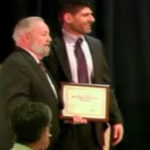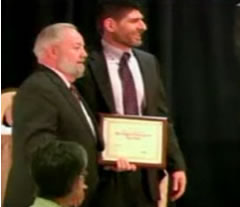
Snow wreaked havoc with travel plans in several U.S. states last week, but the sun was shining in Phoenix on Feb. 11 as eSchool News honored 10 superintendents who are among the nation’s most successful in leading their schools into the 21st century.
The occasion was eSchool News’ Tenth Annual Tech-Savvy Superintendent Awards, sponsored by K12 Inc., the Pearson Foundation, Promethean, and JDL Horizons’ Eduvision. The winners were honored at a private ceremony held in conjunction with the Century Club 100’s annual meeting during the American Association of School Administrators’ National Conference on Education.
Winners were nominated by the school field and then chosen by the editors of eSchool News with the help of Tech-Savvy Superintendent laureates from prior years.
This year’s winners are:
• Eric Conti, Burlington Public Schools, Massachusetts
• Jan Harris, Cullman City Schools, Alabama
• Manuel Isquierdo, Sunnyside Unified School District, Arizona
• Chip Kimball, Lake Washington School District, Washington
• Pamela R. Moran, Albemarle County Public Schools, Virginia
• Carolyn Ross, Churchill County School District, Nevada
• Kim Ross, Houston Public Schools, Minnesota
• Amy Sichel, Abington School District, Pennsylvania
• Gary Smuts, ABC Unified School District, California
• Craig Witherspoon, Edgecombe County Public Schools, North Carolina
For the first time, the ceremony was shown online this year via live streaming video at eSchoolNews.TV. An archived version is now available for viewing.
Click to watch the 2010 TSSA Ceremony on eSN.tv
The ceremony was supposed to feature a keynote speech from Tom Carroll, a former Education Department official during the Clinton administration who is now president of the National Commission on Teaching and America’s Future.
However, Carroll’s travel plans were disrupted by “Snowmageddon,” as the record snowfall in the Washington, D.C., area was being called.
Instead, eSchool News Editor Dennis Pierce talked about the awards program and what it means to be a “tech-savvy” superintendent.
“[It] doesn’t mean you can set up a school network or write lines of code to support your Moodle installation—at least, not necessarily,” Pierce said. “It means you understand how technology can be used to improve instruction and streamline school operations. It means you recognize how technology can be used as a tool to meet the strategic goals of your district, rather than as an end in itself.”
Pierce said he’s been involved in the awards program since its inception, and this year’s awards were the toughest yet to judge.
“We received nearly 400 nominations from districts from coast to coast, and nearly all of those nominated were worthy of inclusion. That’s a good sign for the nation’s schools, I think,” he said.
“For all the talk about how our schools are failing to meet the needs of today’s students, there are many hundreds of school systems whose leaders understand the evolving nature of 21st-century teaching and learning. It seems that being a ‘tech savvy’ K-12 education leader is no longer an exception—and that’s a clear change from when we launched our awards program a decade ago.”
As each winner’s name was called, a short video clip of the honoree describing his or her ed-tech accomplishments played. These accomplishments included one-to-one computing programs that are turning classrooms into student-centered learning labs and boosting achievement; a technology incentive program that is raising the graduation rate and closing the digital divide; and the creation of an online-learning program that has solved the challenge of declining student enrollment in a rural school system. (For more information about this year’s award winners, click here.)
The Tech-Savvy Superintendent Awards are intended to recognize excellence in ed-tech leadership from the very top level of school district administration, and to hold these exemplary leaders up as models for others to follow.
Among other criteria, “tech-savvy” superintendents must model the effective use of technology in their day-to-day execution of the superintendency; ensure that technology resources are distributed equitably among students and staff; insist that adequate professional development is a component of every school technology initiative; demonstrate exceptional vision in leading the development and implementation of a district-wide technology plan; and think creatively and strategically about the long-term challenges and opportunities that technology provides in their district and in education at large. (For a full list of criteria, click here.)
(Editor’s note: For more coverage of AASA’s 2010 National Conference on Education—including what Education Secretary Arne Duncan had to say about NCLB reauthorization and superintendent training programs—see our AASA conference page at eSN Online.)
- Schools and Districts Nationwide Partner with TinkRworks to Engage Students in STEAM Project-Based Learning - November 22, 2024
- BusPatrol Recognized Among Fastest-Growing Companies in North America on the 2024 Deloitte Technology Fast 500™ - November 21, 2024
- Illustration, Comic & Animation App Clip Studio Paint Named Best for Large Screens by Google Play - November 19, 2024



